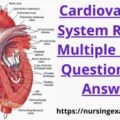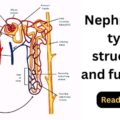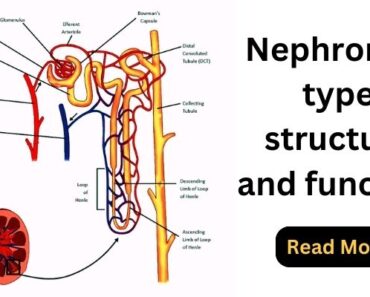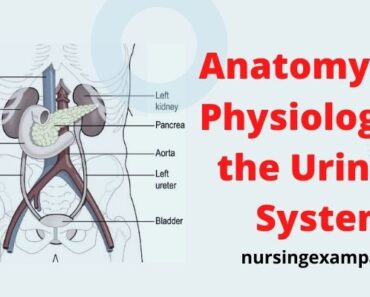The Urinary System is a group of organs, also known as the renal system or urinary tract, the excretory system consists of the two kidneys, two ureters, the bladder, and the urethra. The purpose of the urinary system is to produce, store, and eliminates urine & waste product (ex- ammonia, urea, uric acid, creatinine & bilirubin) from the body, urinary system also work as a regulation of blood plasma electrolyte and blood osmolarity, blood pH, blood volume and BP. The production of hormones is also a major function of the renal system.
We are providing some multiple-choice questions related to the functioning of the urinary system. renal physiology test bank, urinary system quiz for nurses, questions on renal calculi, kidney anatomy MCQs & kidney quiz to improve your knowledge.
renal system multiple-choice questions
MCQs 1. The last part of a nephron is the _____.
A) Collecting Duct
B) Renal papilla
C) Distal convoluted tubule
D) Glomerulus
MCQs 2. Which area actually secretes renin into the blood?
A) Macula densa
B) Juxtaglomerular apparatus
C) Juxtaglomerular cells
D) Cortical nephron
MCQs 3. Which blood vessel conveys blood out of the nephron?
A) Efferent arteriole
B) Vasa recta
C) Peritubular capillary
D) Interlobular vein
MCQs 4. Which blood vessels surround the loops of Henle?
A) Vasa recta
B) Peritubular capillaries
C) Interlobular arteries
D) Efferent arterioles
MCQs 5. Which of the following are not found in the glomerular filtrate?
A) Glucose
B) Protein
C) Uric acid
D) Creatinine
MCQs 6. Which muscle metabolism waste product is eliminated by the kidneys?
A) Urea
B) Uric acid
C) Creatine
D) Creatinine
MCQs 7. Which of these has the highest concentration in the urine?
A) Glucose
B) Sodium
C) Uric acid
D) Phosphate
MCQs 8. Which ion is reabsorbed in exchange for sodium?
A) Chloride
B) Potassium
C) Calcium
D) Magnesium
MCQs 9. What is the average glomerular filtration rate?
A) 10 L per day
B) 180 L per day
C) 1,500 ml per day
D) 1 ml per minute
MCQs 10. Which of the following is usually not found in the urine?
A) Magnesium
B) Urea
C) Uric acid
D) Glucose
Post Basic B.sc Nursing Entrance Exam Question Papers pdf
MCQs 11. How much urine is formed in 24 hours?
A) 12 liters
B) 100 ml
C) 1.5 L
D) 3,000 cc
MCQs 12. Renin acts on _____ to convert it to angiotensin I.
A) Angiotensin II
B) Angiotensinogen
C) ACE
D) Aldosterone
MCQ on the urinary system with answers
MCQs 13. The targets of angiotensin II are blood vessels and _____.
A) Nerves
B) Adrenal cortex
C) Adrenal medulla
D) Kidney nephron
MCQs 14. Tubular re-absorption occurs from the nephron tubules into the _____.
A) Loop of Henle
B) Peritubular capillaries
C) Renal corpuscle
D) Renal pyramid
MCQs 15. Most tubular re-absorption occurs at the _____.
A) Loop of Henle
B) Distal convoluted tubule
C) Proximal convoluted tubule
D) Glomerulus
MCQs 16. Where are most micro-villi found?
A) Loop of Henle
B) Distal convoluted tubule
C) Loop of Henle
D) Proximal convoluted tubule
MCQs 17. Which of the following occurred by active transport?
A) Albumin in the urine
B) Creatinine in the urine
C) Re-absorption of water at the proximal tubule
D) Re-absorption of amino acids
MCQs 18. Which of these does not operate under a renal threshold mechanism?
A) Creatinine
B) Ascorbic acid
C) Sodium
D) Citric acid
MCQs 19. The action of aldosterone is to increase _____.
A) Sodium elimination
B) Sodium reabsorption
C) Potassium reabsorption
D) Chloride excretion
AIIMS Staff Nurse Mock Test Series | Model Paper |Online Exam
MCQs 20. How much sodium is actively reabsorbed by the proximal segment of the nephron?
A) 10%
B) 1%
C) 70%
D) 99%
MCQs 21. The outermost covering of the kidney is the _____.
A) Cortex
B) Medulla
C) Pelvis
D) Capsule
MCQs 22. The kidneys are located in the _____ space.
A) Pelvic cavity
B) Peritoneal cavity
C) Abdominal
D) Retro-peritoneal
MCQs 23. The entrance into the kidney is called the _____.
A) Sinus
B) Column
C) Hilum
D) Pyramid
MCQs 24. Which structure is the first to collect the urine?
A) Pelvis
B) Calyx
C) Ureter
D) Urethra
MCQs on a urinary system with answers
MCQs 25. Each minor calyx receives urine from the _____.
A) Renal papillae
B) Pelvis
C) Ureter
D) Columns
MCQs 26. The renal pyramids are located within the _____.
A) Column
B) Cortex
C) Medulla
D) Pelvis
MCQs 27. The striated appearance of the pyramids is caused by _____.
A) Parallel blood vessels
B) Micro-tubules
C) Connective tissue
D) Nerve fibers
MCQs 28. The kidney secretes ___ for the purpose of stimulating bone marrow activity.
A) Renin
B) Aldosterone
C) Erythropoietin
D) Somatomedin
MCQs 29. The kidney secretes ___, which is an enzyme hormone that raises blood pressure.
A) Aldosterone
B) Renin
C) Angiotensinogen
D) Angiotensin II
Blood MCQs – Question For Nursing Exam
MCQs 30. Uric acid results from _____ metabolism.
A) Protein
B) Carbohydrate
C) Purine
D) Pyrimidine
quizlet urinary system
MCQs 31. Renal secretion of a compound usually occurs from the _____ into the distal convoluted tubule.
A) Loop of Henle
B) Glomerulus
C) Vasa recta
D) Peritubular capillaries
MCQs 32. Which of these is not usually secreted by the kidneys?
A) Creatine
B) Creatinine
C) H +
D) Penicillin
MCQs 33. The compound used to assess the function of the kidney at the level of the glomerulus is _____.
A) Creatinine
B) Insulin
C) Para-aminohippuric acid
D) Creatine
MCQs 34. Which of these could appear in the urine from dieting or the utilization of excess lipids?
A) Urea
B) Uric acid
C) Glycine
D) Ketone
MCQs 35. Vigorous exercise could release high amounts of _____ into the urine.
A) Glucose
B) Uric acid
C) Albumin
D) Ascorbic acid
MCQs 36. What causes urine to flow from the kidneys to the bladder?
A) Gravity
B) Hydrostatic pressure
C) Peristalsis
D) Osmotic pressure
renal system question and answer
MCQs 37. Renal calculi are usually comprised of the following except which one?
A) Calcium oxalate
B) Cholesterol
C) Uric acid
D) Magnesium phosphate
MCQs 38. The mucosa of the bladder is comprised of _____.
A) Smooth muscle
B) Squamous epithelium
C) Transitional epithelium
D) Simple columnar epithelium
MCQs 39. Which of these is under voluntary control?
A) Urethra
B) Detrusor muscle
C) Internal sphincter
D) External sphincter
urinary system multiple-choice questions
MCQs 40. The micturition reflex is centered in the _____.
A) Medulla
B) Sacral cord
C) Hypothalamus
D) Lumbar cord
Dr. NTRUHS MSc Nursing Entrance Exam Paper
MCQs 41. What is the function of the renal system?
A) Maintain blood pH
B) Regulate blood pressure
C) Control blood concentration
D) All of these
MCQs 42. How much of the cardiac output passes through the kidneys?
A) 10%
B) 25%
C) 50%
D) 65%
MCQs 43. Which blood vessel delivers blood to the cortex?
A) Interlobular artery
B) Arcuate artery
C) Interlobar artery
D) Efferent arteriole
MCQs 44. The renal corpuscle is comprised of a glomerulus and _____.
A) Proximal convoluted tubule
B) Bowman’s capsule
C) Loop of Henle
D) Distal convoluted tubule
MCQs 45. Which section of the nephron is after the ascending limb of the loop of Henle?
A) Descending limb of the loop
B) Proximal convoluted tubule
C) Distal convoluted tubule
D) Collecting duct
Renal system MCQ
MCQs 46. The countercurrent multiplier mechanism occurs at the _____.
A) Proximal convoluted tubule
B) Loop of Henle
C) Distal convoluted tubule
D) Collecting ducts
MCQs 47. The fluid in the descending limb of the loop of Henle is _____ relative to the capillaries.
A) Isotonic
B) Weakly hypotonic
C) Strongly hypotonic
D) Hypertonic
MCQs 48. The function of the countercurrent multiplier is to _____.
A) Increase the concentration of NaCl
B) Decrease the concentration of NaCl
C) Change the blood levels of potassium
D) Conserve potassium
MCQs 49. What effect does ADH have on urine output?
A) Minimal
B) Increases
C) Decreases
D) Maintains
MCQs 50. Where does ADH have its greatest effect?
A) Loop of Henle
B) Proximal convoluted tubule
C) Distal convoluted tubule
D) Glomerulus
MCQs 51. Eating large amounts of meat will increase the levels of _____ in the blood.
A) Protein
B) Creatinine
C) Urea
D) Uric acid
Also, Read
What is a nephron, and its type structure function?
Anatomy and Physiology of the Urinary System
AIIMS Staff Nurse Mock Test Series | Model Paper |Online Exam 1st
Nursing Model Question Paper With Answers
Thanks for reading. if you have any query please Mail us. we answer your query as fast as we can.









I need all these mcqs in pdf form is this available in pdf?
more questions
Thank a lot